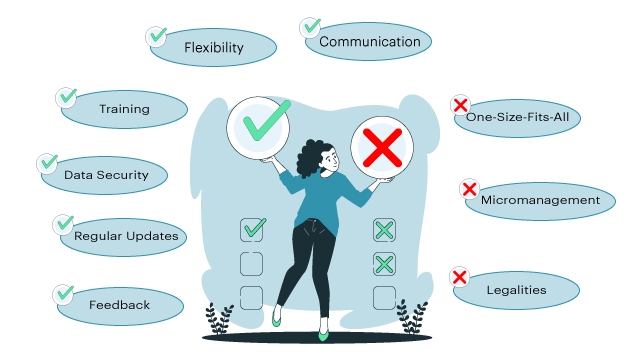Remote work
How to Craft an Effective Remote Work Policy (+ Free Template)
Shyam Nagarajan / Reading Time : 13 mins
The COVID-19 pandemic has forced us to rethink the way we work. Remote work is no longer a perk, as the global health crisis has catapulted it into the mainstream. As a result, businesses have been compelled to rapidly evolve, instituting comprehensive policies like remote work policy, flexible work policy and hybrid work policy to cater to the needs of modern work culture.
In this comprehensive guide, we will explore the nuances of crafting a remote work policy that not only meets the needs of your organisation but also helps establish a framework that fosters productivity, accountability, and work-life balance.
Understanding the basics of the Remote Work Policy
As evident from a study conducted in June 2022 by a Gallup survey, 8 in 10 people are now engaged in hybrid or remote work arrangements, while only 2 in 10 are entirely on-site. What's even more remarkable is that this trend shows no signs of slowing down as we look ahead to the future. Hence, the need for dynamic work policies are becoming imminent.
So, What is a Remote Work Policy?
A remote work policy or hybrid work policy is a formal document created by an organisation that outlines the guidelines, expectations, and procedures for employees who work remotely, either partially or full-time, away from the traditional office environment. This policy serves as a framework to ensure that remote work arrangements are well-structured, consistent, and aligned with the organisation's goals and values.
Based on live booking data from GoFloaters, it is evident that 80% of workers and 60% of organisations are inclined towards hybrid work arrangements, emphasising the necessity for organisations to develop tailored remote, flexible, or hybrid work policies.
Here are some of the key components of a remote work policy:
- Eligibility requirements: Who is eligible to work remotely? This may be based on factors such as job title, level of experience, or performance.
- Approval process: How do employees request to work remotely? What documentation is required?
- Work hours: What are the expected work hours for remote employees? Is there any flexibility?
- Availability: How often are remote employees expected to be available?
- Communication: How will remote employees communicate with their team and managers?
- Productivity: How will remote employees' productivity be measured?
- Tools and Equipment: What tools and equipment will be provided to remote employees?
- Monitoring and Evaluation: How will remote employees be monitored and evaluated?
- Security and privacy: What are the company's security and privacy policies for remote work?
- Challenges of remote work: What are the challenges of remote work, and how will they be addressed?
The specific content of a work from home policy will vary depending on the company's individual needs and circumstances. However, all remote work policies should be clear, concise, and easy to understand. They should also be fair and equitable, and they should protect the interests of both the company and the employee.
How to evaluate remote work policies?
The efficiency evaluation of a remote work policy can vary based on factors like organisation size and industry. Larger organisations often have more resources and infrastructure to support remote work, allowing for more extensive performance metrics such as productivity data, project completion rates, and employee satisfaction surveys. In contrast, smaller companies may rely more on qualitative assessments, like communication effectiveness and individual project outcomes.
Additionally, industry-specific requirements play a crucial role; industries like finance and healthcare may prioritise data security and compliance, while creative industries may focus more on collaboration and innovation. In essence, the evaluation of efficiency in remote work policies is context-dependent and tailored to the unique needs and capabilities of each organisation.
How to Create an Efficient Remote or Hybrid Work Policy?
Investing in an efficient remote work policy is crucial as it empowers organisations to adapt, thrive, and remain competitive. A robust remote work policy promotes inclusivity by accommodating diverse needs and preferences, ultimately driving long-term success for both the organisation and its workforce.
As of 2021, McKinsey reports that many companies are switching to a hybrid work model as remote employees work more than 40 hours, which is 43% more than on-site employees. So, it’s imminent to create a remote or hybrid work policy for the employees to stay competitive and adaptable in the long run.
Here is the step-by-step process for crafting your own remote or hybrid work policy that aligns seamlessly with your organisation's goals and unique culture. Let's dive in!
Needs Assessment:
Begin by conducting a thorough needs assessment. Consider the nature of your business, the roles of your employees, and the unique aspects of your company culture. Tailor the policy to cater to your organisation's specific circumstances and serve as the foundation for your policy.
Clear Expectations:
Establish clear and concise expectations for remote employees. This should encompass performance expectations, availability requirements, and communication guidelines. Consider setting key performance indicators (KPIs) to measure remote employee productivity and success. Regular check-ins can help maintain accountability and track progress.
Equipment and Technology:
Determine how you will address the provision of necessary equipment and technology for remote employees. Decide whether the company will provide laptops, software licences, or stipends for home office setup. Ensuring that your remote team has the necessary tools to perform their tasks efficiently is paramount.
For example, a fully remote social media management software firm called Buffer gives its employees a laptop and $500 to set up a home office, plus additional funds if they need to make use of co-working spaces.
Flexibility and Scheduling:
Strike a balance between flexibility and structure. This should include core work hours but also allow for flexibility in scheduling. Consider how employees can request time off or adjust their work hours to accommodate personal commitments while maintaining productivity. Encourage work-life balance.
Dell, one of the global tech giants, has implemented a flexible workplace programme that lets workers choose their hours and their location. 60% of their workforce is on a flexible working arrangement. Some work remotely full-time, and others have a balance between home and office working arrangements, saving $12 million annually.
Communication Protocols:
The glue that holds remote teams together is effective communication. Encourage open and effective communication while fostering a sense of teamwork and collaboration. Utilise various platforms like Switchboard for real-time collaboration, Slack and Microsoft Teams for instant messaging, Loom for asynchronous communication, and Zoom, Google Meet, and Skype for meetings accordingly.
Training and Support:
Remote employees may require additional training and support to excel in their remote roles. Investing in the skill development and well-being of your remote workforce can yield significant returns. This can be done through platforms like iSpring Learn, a cloud-based platform that offers a powerful tool for remote training and enables the efficient creation and delivery of training content.
Performance Evaluation:
Outline the process for evaluating the performance of remote employees. Consider how promotions and career development opportunities will be managed for remote team members. Ensure that remote employees are evaluated based on results and contributions rather than the number of hours worked. Organisations like Betterworks have outlined efficient frameworks to monitor and assess the performance of their remote employees.
Compensation and Benefits:
Ensure equitable bonus and incentive opportunities for remote staff. Next, define the benefits package, encompassing healthcare, retirement plans, and perks. Be explicit about remote time-off policies, including vacation, sick leave, and holidays, as well as the accrual of benefits like paid time off. Like T-Mobile USA, which provides its employees with an annual work-from-home stipend of $2,000 as part of its benefits package.
Allowances and Expense Reimbursement:
Clearly define policies for reimbursing remote employees' home office expenses, which may include internet costs, phone bills, upgraded internet connections, and office supplies. Specify the expense claim process and any reimbursement limitations. Consider offering allowances or stipends to support remote work. For example, by using PeopleKeep's WorkPerks stipend administration platform, you can easily and quickly reimburse your employees' remote work expenses.
Dos and Don'ts While Creating a Remote Work Policy
Creating a remote work policy can be a complex task, and it's essential to approach it with a clear strategy. Here are some things to keep in mind:
Dos
Communication: Effective communication is paramount in remote work. Make it a top priority to ensure seamless communication within your team. Whenever communication problems arise, address them promptly.
Flexibility: Allow room for flexibility within the policy to accommodate individual needs and changing work environments. A recent study found that hybrid working boosts employee satisfaction and productivity by offering flexibility.
Training: Offering ongoing training and resources to support remote employees and ensuring they remain productive and efficient with the skills and knowledge they need will contribute to their success.
Data Security: Prioritise data security and privacy. Clearly define protocols for handling sensitive information and ensure that remote employees are aware of and comply with these protocols.
Regular Updates: Keep the policy dynamic and up-to-date to adapt to changing circumstances, technologies, and employee feedback. Regularly review and revise the policy as needed to meet the evolving needs of your organisation.
Feedback: Make it a priority to actively seek and integrate feedback from your employees. This approach ensures their satisfaction and enhances the long-term effectiveness of policies. Stay open to their insights and implement adjustments as needed.
Don'ts:
One-Size-Fits-All: Avoid adopting a rigid, one-size-fits-all policy that may not account for individual roles, responsibilities, or unique needs.
Micromanagement: Focus on results and trust employees to manage their work effectively rather than micromanaging and monitoring every hour of their workday.
Legalities: Do not overlook legal and compliance requirements related to remote work, such as labour laws, tax implications, and data protection regulations.
How to Measure the Effectiveness of Your Remote Work Policy
Let's focus on some essential metrics to help assess the effectiveness of a remote work policy below:
-
Key Performance Indicators (KPIs):
- Productivity: Track completed tasks and project milestones to assess remote employees' productivity using platforms like ProHance.
- Communication: Measure response times to emails and messages to gauge communication efficiency.
- Employee Engagement: Use engagement surveys or tools like Gallup Q12 to assess employee satisfaction with remote work.
- Data Security: Monitor adherence to data security protocols to ensure compliance with the guidelines of the organisation.
- Project Management Software: Employ project management software like Asana or Trello to track task progress and collaborate among remote teams efficiently.
- Regular Performance Reviews: Conduct periodic performance reviews focusing on individual contributions and policy adherence.
- Feedback Mechanisms: Establish channels for remote employees to provide input on the policy and act on their feedback.
- Manager Assessments: Gather input from managers on remote team members' performance and policy adherence.
- Cost Analysis: By eliminating the need for physical office spaces, hybrid working adoption can save big companies on average 30-40% in costs and small companies nearly 60%. So, assess cost-effectiveness by comparing expenses with productivity gains and reduced overhead costs.
Remember, the choice of metrics may vary depending on your organisation's specific goals and circumstances, so tailor your approach accordingly.
Remote Work Policy Template
[Your Company Name] Remote Work Policy
Introduction
At [Your Company Name], we recognise the significance of flexibility and work-life balance for our employees. This Remote Work Policy serves to delineate the guidelines and expectations for [Employee Name] and outlines the terms and expectations governing [his/her] remote work arrangement.
Eligibility
[Employee’s Name]'s eligibility for remote work is based on [his/her] exemplary performance, reliability, and the specific needs of [his/her] role. This policy acknowledges [his/her] unique qualifications and responsibilities.
Remote Work Arrangement
[Employee’s Name] is authorised to work remotely on a [part-time/full-time] basis, as mutually agreed upon between [Employee’s Name] and [his/her] supervisor. This arrangement is tailored to [Employee’s Name]'s distinct work requirements and will be reviewed periodically to ensure alignment with [his/her] objectives and the company's needs.
Responsibilities
- [Employee’s Name] will establish and maintain a professional remote work environment conducive to productivity and free from distractions.
- [He/She] will rigorously adhere to all company policies and security protocols while working remotely.
- [Employee’s Name] will remain accessible during [his/her] regular working hours, and any variations will be agreed upon with [his/her] supervisor.
- [He/She] commits to maintaining open and transparent communication with [his/her] colleagues and immediate supervisor.
- Any technical issues or concerns will be reported promptly to the IT department.
- [Employee’s Name] will uphold the utmost confidentiality and security of company information.
Equipment and Resources
[Employee’s Name] will be provided with company-owned equipment and resources necessary for [his/her] remote work. [He/She] is responsible for the secure and responsible management of these assets, with any maintenance or replacement needs facilitated by the organisation.
[List the equipment and resources provided to the employee]
Data Security and Confidentiality
[Employee’s Name] is entrusted with maintaining the highest standards of data security and confidentiality while working remotely. [He/She] will strictly adhere to all company protocols regarding sensitive information and secure network connections.
Communication
Effective communication remains crucial for [Employee’s Name]'s remote work success. [He/She] is expected to be available during regular working hours through email, telephone, and other approved communication channels. Team meetings, project updates, and other communications will continue as usual.
Performance Evaluation
Performance evaluations for [Employee’s Name] will occur regularly, following established procedures applied to in-office personnel. Metrics and job responsibilities will be tailored to [his/her] unique role.
Termination of Remote Work Arrangement
The remote work arrangement for [Employee’s Name] may be concluded at any time, either at [his/her] discretion or in consultation with [his/her] supervisor. Appropriate notice will be provided, and any necessary equipment returns will be arranged.
Compliance with Laws and Regulations
[Employee’s Name] will adhere to all relevant local, state, and federal laws and regulations pertaining to remote work, including tax considerations.
Policy Review
This policy will be reviewed periodically to ensure it continues to align with [Employee’s Name]'s evolving work requirements and the company's objectives.
Acknowledgement
By accepting this remote work policy, [Employee’s Name] acknowledges [his/her] understanding and commitment to its terms.
Name: ____________________________
Signature: ____________________________
Date: _______________
[Your Company Name]
Date: _______________
[Please adapt and revise this template further to suit your organisation's specific needs and legal considerations]
Final Thoughts
Crafting an effective remote or hybrid work policy is imperative for modern organisations. Such policies not only enhance productivity but also attract top talent and contribute to a healthy work culture. Remember that your policy should remain flexible and adaptable and must evolve with the changing needs of your workforce.
If you find yourself in need of workspaces to support your remote or hybrid work initiatives, consider connecting with GoFloaters. Our extensive network of co-working and office spaces can provide the physical infrastructure needed to complement your work from anywhere policy effectively.
Step into the future of work, where a thoughtfully crafted remote or flexible work policy can revolutionise the very essence of work itself. Embrace this transformative wave and watch as your organisation thrives to unprecedented heights, adopting flexibility, productivity, and work-life harmony.



